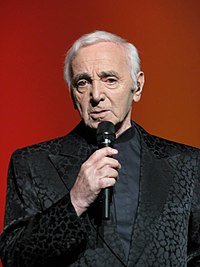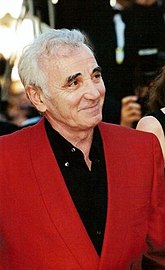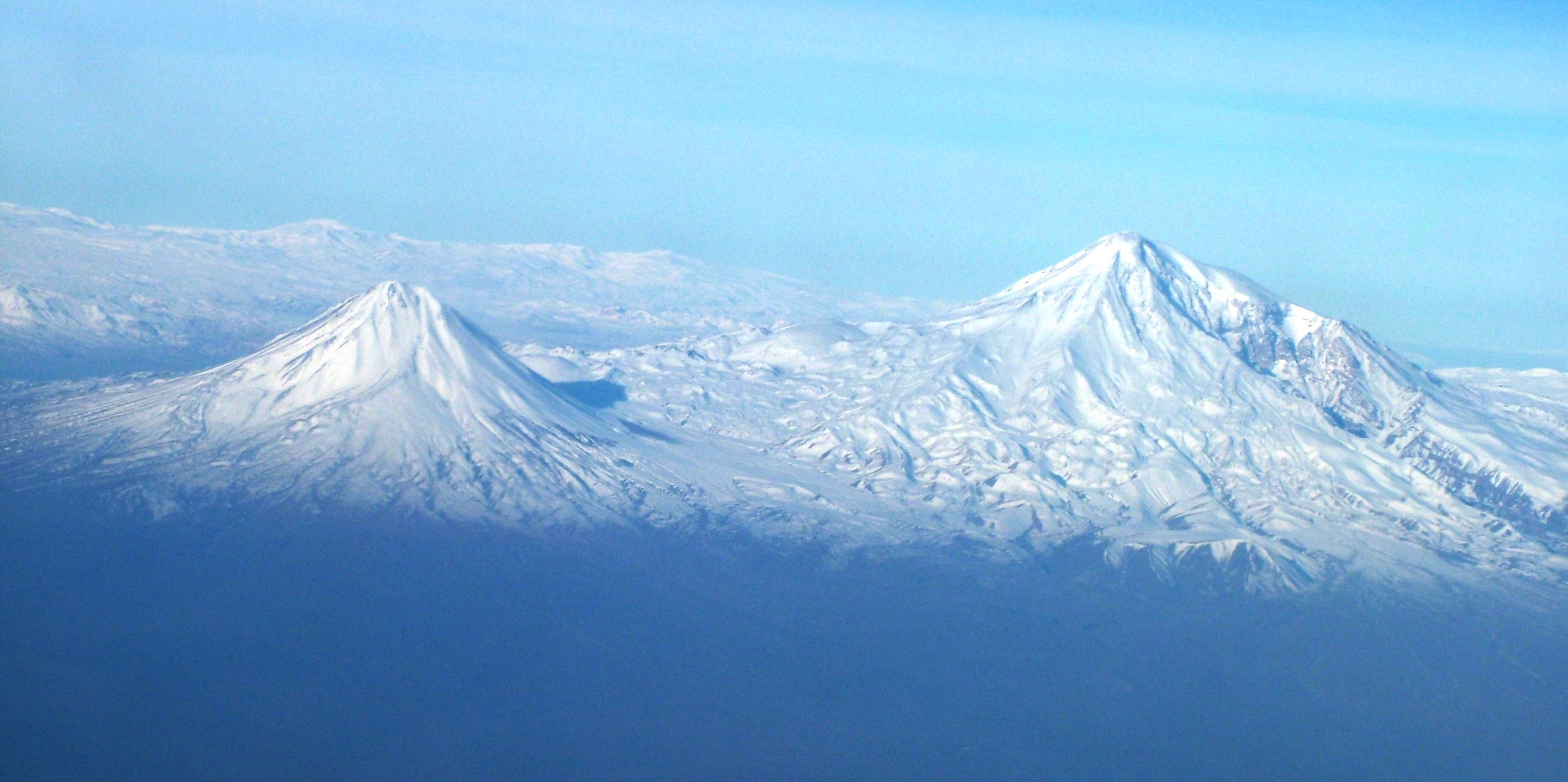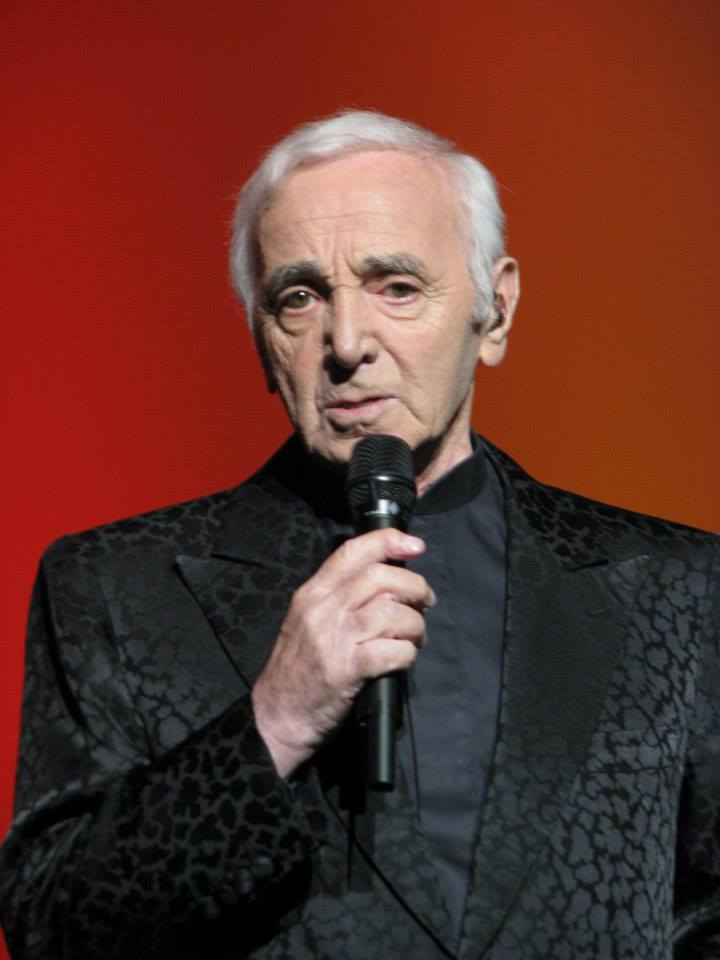Return
|
Ref ID: 1AE2017/1681 | Posted On: 24-01-2017 | Updated on: 24-01-2017
|
|
Charles Aznavour - Singer, Songwriter, Actor...
Charles Aznavour (French pronunciation: [ʃaʁl aznavuʁ]), born Shahnour Varinag Aznavourian (Armenian: Շահնուր Վաղինակ Ազնավուրեան; on 22 May 1924)[1] [A] is a French, later naturalised Armenian,[4] singer, songwriter, actor, public activist and diplomat. Aznavour is known for his unique tenor[5] voice: clear and ringing in its upper reaches, with gravelly and profound low notes. He has written over 800 songs and recorded over 1,200, sung in eight languages[6] and sold more than 180 million records.[7]
He is one of France's most popular and enduring singers.[8][9] He has been dubbed France's Frank Sinatra,[10][11] while music critic Stephen Holden has described Aznavour as "French pop deity."[12] He is also arguably the most famous Armenian of his time.[8][13] In 1998, Aznavour was named Entertainer of the Century by CNN and users of Time Online from around the globe. He was recognized as the century's outstanding performer, with nearly 18% of the total vote, edging out Elvis Presley and Bob Dylan.[14]
He has sung for presidents, popes and royalty, as well as at humanitarian events. In response to the 1988 Armenian earthquake, he founded the charitable organization Aznavour for Armenia along with his long-time friend impresario Levon Sayan. In 2009, he was appointed ambassador of Armenia to Switzerland, as well as Armenia's permanent delegate to the United Nations at Geneva.[15] Aznavour is the longest standing “A list” star, still filling major venues all over the world.[16] He started his most recent tour in 2014
| Charles Aznavour | |
|---|---|
 Charles Aznavour in June 2014 |
|
| Background information | |
| Birth name | Shahnour Varinag Aznavourian |
| Born | 22 May 1924 Paris, France |
| Genres | |
| Occupation(s) |
|
| Years active | 1933–present |
| Labels | |
| Website | charlesaznavour |
Life and career

Aznavour with his mother, Knar, in the 1920s.
Background
Aznavour was born with the name Shahnour (or Chahnour)[2] Vaghinag (Vaghenagh)[3] Aznavourian[1] (Armenian: Շահնուր Վաղինակ Ազնավուրեան) in Saint-Germain-des-Prés, Paris, to Armenian immigrants Michael Aznavourian (from Akhaltsikhe, Georgia)[1][17] and Knar Baghdasarian, an Armenian from İzmir, Turkey.[18][19] His father sang in restaurants in France before establishing a Caucasian restaurant called Le Caucase. Charles's parents introduced him to performing at an early age, and he dropped out of school aged nine, taking the stage name "Aznavour". His big break came in 1946 when the singer Édith Piaf heard him sing and arranged to take him with her on tour in France and to the United States.[20]
Music
Aznavour was already familiar with performing on stage by the time he began his career as a musician. At the age of nine, he had roles in a play called Un Petit Diable à Paris and a film entitled La Guerre des Gosses.[21] Aznavour then turned to professional dancing and performed in several nightclubs. In 1944, he and actor Pierre Roche began a partnership and in collaborative efforts performed in numerous nightclubs. It was through this partnership that Aznavour began to write songs and sing. The partnership's first successes were in Canada in 1948-1950. Meanwhile, Aznavour wrote his first song entitled J'ai Bu in 1950.[21]
During the early stages of his career, Aznavour opened for Edith Piaf at the Moulin Rouge. Piaf then advised Aznavour to pursue a career in singing. Piaf helped Aznavour develop a distinctive voice that stimulated the best of his abilities.[21]
Sometimes described as "France's Frank Sinatra",[10] Aznavour sings frequently about love. He has written musicals and about more than eight hundred songs, and made more than one hundred records. Aznavour's voice is shaded towards the tenor range, but possesses the low range and coloration more typical of a baritone, contributing to his unique sound. Aznavour speaks and sings in many languages (French, English, Italian, Spanish, German, Russian, Armenian, Neapolitan), which has helped him perform at Carnegie Hall, in the USA, and other major venues around the world. He also recorded at least one song from the 18th century Armenian poet Sayat Nova, and a popular song, Im Yare[22] in Armenian. Que C'est Triste Venise, sung in French, Italian (Com'è Triste Venezia), Spanish (Venecia Sin Ti), English (How Sad Venice Can Be), and German (Venedig in Grau), is one of Aznavour's most famous multilingual songs.
In 1974, Aznavour became a major success in the United Kingdom where his song "She" went to Number One in the charts three times faster than anyone else's. His other well-known song in the UK was "Dance in the Old Fashioned Way".[23]

Aznavour and Norwegian singer Sissel Kyrkjebø performing in Vienna
Artists who have recorded his songs and collaborated with Aznavour include Édith Piaf, Fred Astaire, Frank Sinatra (Aznavour was one of the rare European singers invited to duet with him[24]), Andrea Bocelli, Bing Crosby, Ray Charles, Bob Dylan (he named Aznavour among the greatest live performers he's ever seen),[25][26] Liza Minnelli, Elton John, Dalida, Serge Gainsbourg, Josh Groban, Petula Clark, Tom Jones, Shirley Bassey, José Carreras, Laura Pausini, Nana Mouskouri and Julio Iglesias. Fellow French pop legend Mireille Mathieu has sung and recorded with Aznavour on numerous occasions. In 1974, Jack Jones recorded an entire album of Aznavour compositions entitled "Write Me A Love Song, Charlie", re-released on CD in 2006.[27][28] Aznavour and Italian tenor Luciano Pavarotti sang Gounod's aria Ave Maria together. He performed with famed Russian cellist and friend Mstislav Rostropovich to inaugurate the French presidency of the European Union in 1995. Elvis Costello recorded "She" for the film Notting Hill. One of Aznavour's greatest friends and collaborators from the music industry is legendary Spanish operatic tenor Plácido Domingo, who often performs his hits, most notably a solo studio recording of "Les bateaux sont partis" in 1985 and duet versions of the song in French and Spanish in 2008, as well as multiple live renditions Aznavour's "Ave Maria". In 1994, Aznavour performed with Domingo and Norwegian soprano Sissel Kyrkjebø at Domingo's third annual Christmas in Vienna concert. The three singers performed a variety of carols, medleys, and duets, and the concert was televised throughout the world, as well as released on a CD internationally.[29]

Charles Aznavour in concert (1988)
At the start of autumn 2006, Aznavour initiated his farewell tour, performing in the US and Canada, and earning very positive reviews. Aznavour started 2007 with concerts all over Japan and Asia. The second half of 2007 saw Aznavour return to Paris for over 20 shows at the Palais des Congrès in Paris, followed by more touring in Belgium, the Netherlands, and the rest of France. Aznavour had repeatedly stated that this farewell tour, health permitting, would likely last beyond 2010; since then, however, Charles Aznavour has continued performing worldwide throughout the year. At 92, Aznavour is in excellent health, although admittedly 60 years on stage have made him "a little hard of hearing".[30] He still sings in multiple languages and without persistent use of teleprompters, but typically sticks to just two or three (French and English being the primary two, with Spanish or Italian being the third) during most concerts.[31] On 30 September 2006, Aznavour performed a major concert in Yerevan, the capital of Armenia to start off the cultural season "Arménie mon amie" in France. Armenian president Robert Kocharyan and French president Jacques Chirac, at the time on an official visit to Armenia, were in front-row attendance.[32]

Aznavour at the 1999 Cannes Film Festival.
In 2006 Aznavour recorded his album Colore Ma Vie in Cuba, with Chucho Valdés. It was presented at his Moscow concert in April 2007. Later, in July 2007, Aznavour was invited to perform at the Vieilles Charrues Festival.
"Forever Cool" (2007), an album from Capitol/EMI, features Aznavour singing a new duet of "Everybody Loves Somebody Sometime" with the voice of the late Dean Martin.
On 18 January 2008, he participated as guest vocalist with the contestants of the French reality show Star Academy and sang his famous Emmenez-Moi with contestant Jérémy Chapron. Aznavour finished a tour of Portugal in February 2008. Throughout the spring of 2008, Aznavour toured South America, holding a multitude of concerts in Argentina, Brazil, Chile and Uruguay. Summer saw him in Quebec, and a return to Latin America followed in autumn.
An admirer of Quebec, where he played in Montreal cabarets before becoming famous, he has helped the career of Québécoise singer-songwriter Lynda Lemay in France, and has a house in Montreal. On 5 July 2008, he was invested as an honorary officer of the Order of Canada. He performed the following day on the Plains of Abraham as a feature of the celebration of the 400th anniversary of the founding of Quebec City.[33]
In 2008, an album of duets, Duos, was released. It is a collaborative effort featuring Aznavour and his greatest friends and partners from his long career in the music industry, including Céline Dion, Sting, Laura Pausini, Josh Groban, Paul Anka, Plácido Domingo, and many others.[34] It was released on various dates in December 2008 across the world.[35] His next album, Charles Aznavour and The Clayton Hamilton Jazz Orchestra (previously known as Jazznavour 2), is a continuation in the same vein as his hit album Jazznavour released in 1998, involving new arrangements on his classic songs with a jazz orchestra and other guest jazz artists. It was released on 27 November 2009.[36]
Aznavour and famed Senegalese singer Youssou N'Dour, with the collaboration of over 40 of France's most celebrated singers and musicians, recorded a music video with the music group Band Aid in the aftermath of the catastrophic 2010 Haiti earthquake, titled "1 geste pour Haïti chérie".[37]
In 2009, Aznavour also toured across America. The tour, named Aznavour en liberté,[38] started in late April 2009 with a wave of concerts across the United States and Canada, took him across Latin America in the autumn, as well as the USA once again. In August 2011 Aznavour released a new album, Aznavour Toujours, featuring 11 new songs, and Elle, a French re-working of his greatest international hit, She. Following the release of Aznavour Toujours, 87 years old Aznavour began a tour across France and Europe, named Charles Aznavour en Toute Intimité, which started with 21 concerts in the "Olympia" theatre in Paris.[39] On 12 December 2011 he gave a concert in Moscow State Kremlin Palace that attracted a capacity crowd.[40] The concert was followed by a standing ovation which continued for about fifteen minutes.[41]
In 2012, Aznavour embarked on a new North American leg of his "En toute intimité" tour, visiting Québec and the Gibson Amphitheatre in Los Angeles, the third-largest such venue in California, for multiple shows. The shows in New York were cancelled following a contract dispute.[42] On 16 August 2012 Aznavour performed in his father's birthplace Akhaltsikhe in Georgia. Part of the concert was broadcast on Georgian television.
On 25 October 2013 Aznavour performed in London for the first time in 25 years at the Royal Albert Hall; demand was so high that a second concert at the Royal Albert Hall was scheduled for June 2014.[43] In November 2013, Aznavour appeared with Achinoam Nini (Noa) in a concert, dedicated to peace, at the Nokia Arena in Tel Aviv.[44] The audience, including Israeli president Shimon Peres (Peres and Aznavour had a meeting prior to the performance), sang along.[45] In December 2013 Aznavour gave two concerts in the Netherlands at the Heineken Music Hall in Amsterdam, and again in January 2016 (originally scheduled for November 2015 but postponed due to a brief stomach flu.[46])
In 2014, 2015 and 2016, Aznavour continued his international tournée with a lot of big concerts in various countries, e.g. Bruxelles, Berlin, Francfort/Main, Barcelone, Madrid, Warsaw, Prague, Moscow, Bucarest, Antwerp, London, Dubai, Canada (Montreal), USA (New York, Boston, Miami, Los Angeles), Japan (Osaka, Tokyo), Marbella, Monaco, Verone, Amsterdam.
Film

Charles Aznavour, Armen Martirosyan and Djivan Gasparyan in Yerevan
See: Filmography
Aznavour has had a long and varied parallel career as an actor, appearing in over 60 films. In 1960 Aznavour starred in François Truffaut's Tirez sur le pianiste, playing a character called Édouard Saroyan. He also put in a critically acclaimed performance in the 1974 movie And Then There Were None. Aznavour had an important supporting role in 1979's The Tin Drum, winner of the Academy Award for Best Foreign Language Film in 1980. He co-starred in Claude Chabrol's Les Fantômes du chapelier (1982). In the 1984 version of Die Fledermaus, he appears and performs as one of Prince Orlovsky's guests. This version stars Kiri Te Kanawa and was directed by Plácido Domingo in the Royal Opera House at Covent Garden.[47] Aznavour starred in the 2002 movie Ararat playing Edward Saroyan, a movie director.
Armenia and abroad
Since the 1988 Armenian earthquake, Aznavour has been helping the country through his charity, Aznavour for Armenia. Together with his brother in-law and co-author Georges Garvarentz he wrote the song "Pour toi Arménie", which was performed by a group of famous French artists and topped the charts for eighteen weeks. There is a square named after him in central Yerevan on Abovian Street, and a statue erected in Gyumri, which saw the most lives lost in the earthquake. In 1995 Aznavour was appointed an Ambassador and Permanent Delegate of Armenia to UNESCO. Aznavour is a member of the Armenia Fund International Board of Trustees. The organization has rendered more than $150 million in humanitarian aid and infrastructure development assistance to Armenia since 1992. He was appointed as "Officier" (Officer) of the Légion d'honneur in 1997. In 2004 Aznavour received the title of National Hero of Armenia, Armenia's highest award. On 26 December 2008, President of Armenia Serzh Sargsyan signed a presidential decree for granting citizenship for the Republic of Armenia to Aznavour whom he called a "prominent singer and public figure" and "a hero of the Armenian people".[4][48]
In 2011 the Charles Aznavour Museum opened in Yerevan, Armenia.[49]
In April, 2016 Aznavour visited Armenia to participate in the Aurora Prize Award ceremony. On 24 April, along with Serzh Sargsyan, the Catholicos of All Armenians, His Holiness Garegin II and actor George Clooney, he laid flowers at the Armenian Genocide Memorial.[50][51]
Personal life and cultural impact

Charles Aznavour in the late 2000s
Aznavour has been married three times, to Micheline Rugel (1946),[52] Evelyn Plessis (1956) and current wife Ulla Thorsell (1967). Six children were produced by these marriages: Séda, Charles, Patrick, Katia, Mischa, and Nicolas.[53] In 1990, he offered insights into his life to writer-director Michael Feeney Callan in the TV series My Riviera[54] which was filmed at and around Aznavour's home in Port Grimaud, in the South of France. He currently resides in St-Sulpice, Vaud, Switzerland.[55]
His musicality and fame abroad is present in many other areas of pop culture. Aznavour's name was used as the basis for the name of the character Char Aznable by Yoshiyuki Tomino in his 1979 mecha anime series, Mobile Suit Gundam. His song "Parce que tu crois" was sampled by Hip Hop producer Dr. Dre for the song "What's the Difference" (feat. Eminem & Xzibit), from his album 2001.[56] He is mentioned in The Psychedelic Furs song "Sister Europe" ("The radio upon the floor/ is stupid, it plays Aznavour") and the Kemal Monteno song "Stavi tiho Aznavoura" ("Play Aznavour quietly").
He has often joked about his physicality, the most talked about feature which is his height; he stands 160 cm (5 ft 3 in) tall, and Aznavour has made this a source of self-deprecating humour over the years.[21]
Politics
Aznavour has been increasingly involved in French, Armenian and international politics as his career progressed. During the 2002 French presidential elections, when socially conservative nationalist Jean-Marie Le Pen of the National Front made it into the runoff election, facing incumbent Jacques Chirac, Aznavour signed the "Vive la France" petition, and called on all French to "sing the Marseillaise" in protest.[57] Chirac, a personal friend of Aznavour's, ended up winning in a landslide, carrying over 82% of the vote.
He has written a song about the Armenian Genocide, titled "Ils sont tombés" (known in English as "They fell").
He has frequently campaigned for international copyright law reform. In November 2005 he met with President of the European Commission José Manuel Barroso[58] on the issue of the review of term of protection for performers and producers in the EU, advocating an extension of the EU's term of protection from the current 50 years to the United States' law allowing 95 years, saying "[o]n term of protection, artists and record companies are of the same mind. Extension of term of protection would be good for European culture, positive for the European economy and would put an end the current discrimination with the U.S." He has also notably butted heads with French politician Christine Boutin over her defense of a "global license" flat-fee authorization for sharing of copyrighted files over the Internet, claiming that the license would eliminate creativity. In May 2009 the French Senate approved one of the strictest internet anti-piracy bills ever with a landslide 189–14 vote. Aznavour was a vocal proponent of the measure and considered it a rousing victory:
"If the youth can't make a living through creative work, they will do something else and the artistic world will be dealt a blow... There will be no more songs, no more books, nothing at all. So we had to fight..."[59]
Along with holding the mostly ceremonial title of French ambassador-at-large to Armenia, Aznavour agreed to hold the position of Ambassador of Armenia to Switzerland on 12 February 2009:
"First I hesitated, as it is not an easy task. Then I thought that what is important for Armenia is important for us. I have accepted the proposal with love, happiness and feeling of deep dignity"[60]
Aznavour, in his position as Armenia's Ambassador to Switzerland, has been criticized for failing to file his financial disclosures with Armenia's Commission on Ethics of High-Ranking Officials, a requirement for all top government officials, including ambassadors.[61]
Awards and recognition
Honours
- 1995 – Grand Medal of the French Academy
- 1997 – Officier (Officer) of the Legion d'honneur[62]
- 2008 – Honorary Officer of the Order of Canada[63]
- 2009 – Officer of the National Order of Quebec[64]
- 2015 – Commander in the Order of the Crown, By royal decree. [65]
Awards

Statue of Aznavour in Gyumri, Armenia

Charles Aznavour Museum in Yerevan
- 1960 – Grand Prix Award for Best Italian Song
- 1963, 1971, and 1980 – Edison Awards (three-time award winner)[66]
- 1971 – Golden Lion Honorary Award at the Venice Film Festival for the Italian version of the song Mourir d'aimer
- 1995 – Ambassador of Goodwill and Permanent Delegate of Armenia to UNESCO[67]
- 1996 – Induction into the Songwriters Hall of Fame
- 1997 – French Victoire award for Male artist of the year
- 1997 – Honorary César Award
- 2004 – National Hero of Armenia[68]
- 2006 – Honorary prize at 30th Cairo Film Festival
- 2008 – Citizenship of the Republic of Armenia[4]
- 2009 – MIDEM Lifetime Achievement Award[69]
- 2009 – Grigor Lusavorich award of Nagorno-Karabakh Republic[70]
- 2009 – Honorary Doctorate from the University of Montreal
- 2010 – Honorary order from Russia "For contributing to strengthening cultural relations between Russia and France"[71]
- 2014 – Special Prize named after Rouben Mamoulian of the "Hayak" National Film Awards in Armenia for "his great contribution to world cinema"[72]
- 2016 - Honorary Hollywood Star plaque from the Hollywood Chamber of Commerce[73]
Discography
Main article: Charles Aznavour discography
Filmography
- La Guerre des gosses (1936) … Extra
- Goodbye Darling (1946) (as Aznavour) … Le duettiste
- Entrez dans la danse (1948)
- Une gosse sensass' (1957) … Le chanteur
- Paris Music Hall (1957) … Charles
- La Tête contre les murs (1959) … Heurtevent
- Les Dragueurs (1959) … Joseph Bouvier
- Pourquoi viens-tu si tard? (1959) … Un danseur
- Oh! Qué mambo (1959) … Un spectateur au cabaret (uncredited)
- Le Testament d'Orphée (1960) … The curious man (uncredited)
- Un taxi pour Tobrouk (1960) … Samuel Goldmann
- Tomorrow Is My Turn (Le Passage du Rhin) (1960) … Roger
- Tirez sur le pianiste (1960) … Charlie Kohler/Édouard Saroyan
- Gosse de Paris (1961)
- Les Lions sont lâchés (1961) … Charles, un convive de Marie-Laure
- Esame di guida … tempo di Roma (1962) … Marcello
- Horace 62 (1962) … Horace Fabiani
- Le Diable et les dix commandements (1962) … Denis Mayeux (episode "Homicide point ne seras")
- Les Quatre vérités (1962) … Charles
- Les Vierges (1963) … Berthet
- Cherchez l'Idole (1963) … Aznavour
- Le Rat d'Amérique (1963) … Charles
- Thomas l'imposteur (1964)
- Alta infedeltà (1964) … Giulio (segment "Peccato nel Pomeriggio")
- La Métamorphose des cloportes (1965) … Edmond
- le facteur s'en va-t-en guerre (1966) … Thibon
- Paris au mois d'août (1966) … Henri Plantin
- Caroline chérie (1968) … Postillon
- Candy (1968) … Hunchback juggler
- Le Temps des loups (1969) … Inspector
- The Adventurers (1970) … Marcel Campion
- L'Amour (1970) … Le présentateur
- The Games (1970) … Pavel Vendek
- The Selfish Giant (1971) … Narrator (French version)
- Un beau monstre (1971) … Inspector Leroy
- The Lion's Share (1971) … Éric Chambon
- Les Intrus (1972) … Charles Bernard
- The Blockhouse (1973) … Visconti
- And Then There Were None (1974) … Michel Raven
- Sky Riders (1976) … Insp. Nikolidis
- Folies bourgeoises (1976) … Dr. Lartigue
- The Muppet Show (1977) … Guest appearance
- Die Blechtrommel (1979) … Sigismund Markus
- Ciao, les mecs (1979) … L'amnésique
- The Magic Mountain (1982) … Naphta
- Qu'est-ce qui fait courir David? (1982) … Léon, le père de David
- Les Fantômes du chapelier (1982) … Kachoudas
- Une jeunesse (1983) … Bellun
- Viva la vie! (1984) … Édouard Takvorian
- Yiddish Connection (1986) … Aaron Rapoport
- Mangeclous (1988) … Jérémie
- Il Maestro (1989) … Romualdi
- Le chinois (1989) … Charles Cotrel
- Charles Aznavour Armenia 1989 (1989)
- Les Années campagne (1992) … Grandfather
- Pondichéry, dernier comptoir des Indes (1997) … Léo Bauman
- Le Comédien (1997) … Monsieur Maillard
- Laguna (2001)
- The Truth About Charlie (2002) … Himself
- Ararat (2002) … Edward Saroyan
- Le Père Goriot (2004) … Jean-Joachim Goriot
- Ennemis publics (2005)
- The Colonel (2006) … Père Rossi
- Up (2009) … Carl Fredricksen (French voice)
Documentary films
- Charles Aznavour – Armenia 1989 (1989) – About the humanitarian aid that Aznavour brought to his native Armenia after the 1988 Armenian earthquake.[74]
- Christmas in Vienna III (1994) – A Christmas gala concert with Aznavour, Plácido Domingo and Sissel Kyrkjebø, featuring the Vienna Symphony conducted by Croatian conductor Vjekoslav Šutej.
- Making of "Colore Ma Vie" (2007) – A featurette accompanying the release of Aznavour's studio album Colore Ma Vie. Filmed in Havana and Paris, it shows his collaboration with Chucho Valdez.



